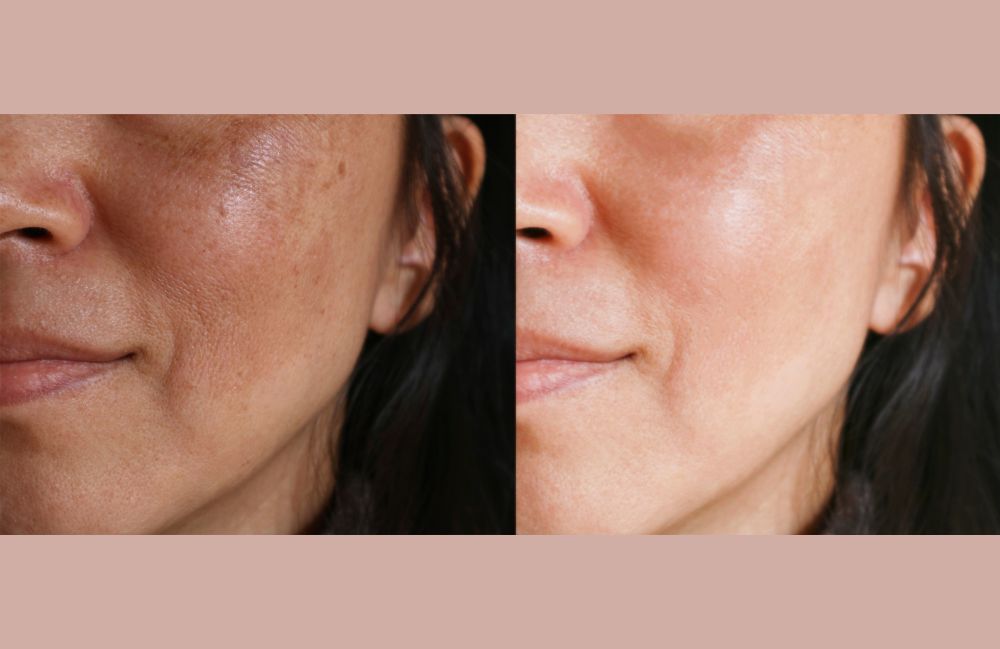
Understanding Melasma
Melasma manifests as symmetrical patches of discoloration on areas of the skin that are frequently exposed to sunlight. The most commonly affected facial regions include:
- Bridge of the nose
- Forehead
- Cheeks
- Upper lip
- Chin
Additionally, melasma can appear on other sun-exposed areas of the body, such as the forearms, neck, and shoulders.
Causes and Risk Factors
The exact cause of melasma remains unclear, but several factors are believed to contribute to its development:
- Sun Exposure: Ultraviolet (UV) radiation stimulates melanocytes, the cells responsible for pigment production, leading to the formation of melasma.
- Hormonal Changes: Pregnancy, use of oral contraceptives, and hormone replacement therapy have been linked to melasma, suggesting a hormonal component.
- Genetics: A family history of melasma increases the likelihood of developing the condition.
- Skin Type: Individuals with darker skin tones have more active melanocytes, making them more susceptible to melasma.
It is important to note that while melasma is harmless, it can cause significant cosmetic concern due to its appearance.
Diagnosis
A thorough examination by a dermatologist is essential for an accurate diagnosis of melasma. At Metropolis Dermatology, our specialists will assess your skin’s appearance and may use a Wood’s lamp, which emits UV light, to determine the depth of pigmentation. In rare cases, a skin biopsy may be performed to rule out other conditions.
Treatment Options
Treating melasma can be challenging, and a combination of therapies is often most effective. Our approach at Metropolis Dermatology includes:
- Metropolis Skincare (Topical Treatments): Prescription creams containing hydroquinone, tretinoin, corticosteroids, or a combination thereof can lighten hyperpigmented areas.
- Chemical Peels: Superficial chemical peels using agents like glycolic acid can exfoliate the skin and reduce pigmentation.
- Laser and Light Therapies: Advanced treatments such as fractional lasers or intense pulsed light (IPL) can target and break down pigment deposits.
- Oral Medications: In certain cases, oral medications like tranexamic acid may be prescribed to manage melasma.
It is important to understand that treatment responses vary, and maintenance therapy may be necessary to prevent recurrence.

FAQs
Is melasma a permanent condition?
Melasma is a chronic skin condition that can persist for years, but with proper treatment and sun protection, its appearance can be significantly reduced and managed over time.
Can melasma go away on its own?
In some cases, melasma may fade on its own, particularly if it was triggered by pregnancy or hormonal changes. However, for many individuals, treatment is necessary to achieve noticeable improvement.
What is the best treatment for melasma?
The most effective approach is a combination of topical treatments, chemical peels, laser therapy, and strict sun protection. A customized treatment plan based on your skin type and severity of melasma yields the best results.
Does sun exposure make melasma worse?
Yes. UV exposure is the primary trigger for melasma and can worsen existing pigmentation. Daily broad-spectrum sunscreen use and protective measures are essential for managing melasma.
Can laser treatments remove melasma completely?
Laser treatments can significantly lighten melasma, but they are not always a permanent cure. Without proper maintenance and sun protection, melasma may return.
Hear from
Real Patients

Schedule Your Consultation Today!
At Metropolis Dermatology in Costa Mesa, CA, we are committed to providing comprehensive care for individuals affected by melasma. Our team of experienced dermatologists will work with you to develop a personalized treatment plan aimed at achieving optimal results. Contact us today to schedule a consultation and take the first step toward clearer, healthier skin!
